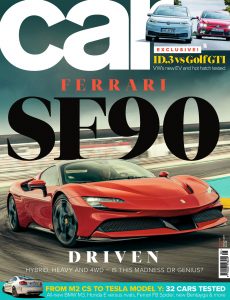
Car UK – August 2020
English | 149 pages | pdf | 154.07 MB
Miniature wrenches, fiddly diffs and tyreshredding drifts
If Zoom video conferencing is having a good pandemic (on the last day of January its share value was $76; by 26 June it was $257), Tamiya isn’t far behind. Since Covid-19 sent us all home, UK demand for the maker’s detailed
and brilliantly executed kits has consistently matched the kind of rush it normally sees in the run-up to Christmas.
For readers of a certain age, Tamiya is synonymous with the radio-controlled buggies that exploded in popularity in the ’80s. Hornet. Monster Beetle. Grasshopper. If, as a pre-teen, you spent your time assembling little oil filled dampers and launching your finished buggy from ramps of planks and bricks, those names are as familiar – as magical – as 959, Countach and Testarossa. And when you suddenly find yourself with a lot of leisure time (and some faintly depressing current affairs), what better escapism than diving back into a world of miniature wrenches, fiddly differentials and tyre-shredding drifts?
Obsessed with Tamiya from the moment I got my first catalogue, I’ve come to think of the model company as a kind of Honda twin. Both were founded in the aftermath of the Second World War: Tamiya in ’46 as a sawmill that
diversified into wooden model kits; Honda in the same year as a maker of bicycles with bolt-on petrol engines. Both found their feet in the ’60s: Tamiya with a move to plastic kits; Honda via world-leading engineering, race success and an inspired move into the North American market with its motorcycles. Both had heydays in the ’80s: Tamiya with the radio-controlled buggy boom it helped create (the ’79 Sand Scorcher and Rough Rider are seen as landmark releases); Honda with cars like the CRX and NSX, its fine F1 engines of the period and a ramping-up of motorcycle production that saw it hit a cumulative total of 50 million units in 1984.
Both have used genius slogans: Tamiya’s ‘First in quality around the world’; Honda’s ‘You meet the nicest people on a Honda’. Both have long prioritised quality over a lightweight or cut-price approach. Both have dabbled in expensive, idiosyncratic and sometimes unsuccessful engineering solutions: Tamiya with its flawed Avante flagship; Honda with the slow-selling hybrid NSX and its perverse NR four-stroke and ‘upside-down’ two-stroke NSR 500cc Grand Prix motorcycles. Both owe much of their success to bold corporate identities and strong visual branding: Tamiya’s logo is a graphical masterpiece and its box lids and build manuals works of art in their own right (when Caterham overhauled its self-build manual, it looked to Tamiya’s instructions); Honda’s wing has graced every motorcycle it’s built since the late ’40s.
Pleasing, then, that my pandemic home ‘office’ (a draughty garage with no heating or windows) is home to an actual Honda and more distracting Tamiya Hondas than is ideal for peak productivity.
If you’re struggling to find us in the shops please consider a subscription. Head over to the greatmagazines.co.uk website or access us on your phone or tablet by downloading our app from the Apple or Android stores.
Ben
Miller
Editor
Download from: